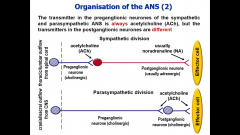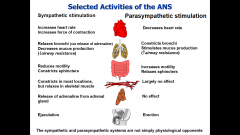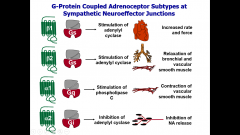![]()
![]()
![]()
Use LEFT and RIGHT arrow keys to navigate between flashcards;
Use UP and DOWN arrow keys to flip the card;
H to show hint;
A reads text to speech;
19 Cards in this Set
- Front
- Back
|
What two categories can the nervous system be broadly divided into? |
Central nervous system and the peripheral nervous system |
|
|
What is the autonomic nervous system (ANS) responsible for? |
For carrying output from the CNS to the whole of the body with the exception of the skeletal muscle |
|
|
Give some functions of the ANS |
1) regulates visceral functions that are largely involuntary and which do not require concious effort eg heartbeat, exocrine and some endocrine secretions, contraction of vascular and visceral smooth muscle, apects of metabolism Training allows a degree of control of some ANS functions |
|
|
What is the ANS subdivided into? |
sympathetic and parasympathetic divisions |
|
|
How do the two subdivisions work? |
Work in an opposing fashion to maintain homeostasis: Parasympathitic ANS- coordinates the bodies basic homeostatic functions Sympathetic ANS- coordinates the bodys response to stress associated with fight, flight and fright reactions |
|
|
What is the Autonomicganglion? |
An autonomic ganglion is a cluster of nerve cell bodies (a ganglion) in the autonomic nervous system. The two types are sympathetic ganglion and parasympatheticganglion. |
|
|
What is the trasmitter in the preganglionic neurons of the sympathetic and parasympathetic ANS? |
ALWAYS acetylcholine |
|
|
What is the trasmitter in the postganglionic neurons of the sympathetic and parasympathetic ANS? |
different, usually noradrenaline |
|
|
What is the difference in distance of the preganglonic and post ganglionic in the symapthetic vs the parasymathetic |

|
|
|
Show the sympathetic outflow |

|
|
|
Where are the parasympathetic ganglia usually located? |
in the target organs (discrete ganglia in head and neck) |
|
|
give some examples of the activities of the ANS with sympathetic function vs parasympathetic function |

|
|
|
What is the process of chemical transmission in the ANS in the sympathetic division |
1) action potential originates in the CNS 2) travels to the presynaptic terminal of the preganglionic neuron triggering Ca2+entry and the release of ACh 3) ACh opens ligand-gated ion channels (nicotinic receptors) in the postganglionic neuron, causing depolarization and the generation of action potentials that travel to the presynaptic terminal of the neurone triggering Ca2+ entry and the release of noradrenaline 4) This activated G-protein coupled adrenoceptors in the target cell membrane causing a cellular response. |
|
|
What is the process of chemical transmission in the ANS in the parasympathetic division |
Theprocess is identical to that described for the sympathetic division, with theexception that: 1) ACh is always the transmitter used by postganglionic neurons 2) ACh activates G-protein-coupledmuscarinicacetylcholinereceptors in the targetcell membrane to cause a cellular response |
|
|
Give examples of 3 G-protein coupled muscarinic ACh receptor subtypes |
1) M1 (Muscarinic AChReceptor) to Gq (G-protein) 2) M2 to Gi 3) M3 to Gq |
|
|
What is the funtion of M1 to Gq? |
Stimulation of phospholipase in the stomach resulting in increased acid secretion |
|
|
What is the function of M2 to Gi? |
Inihibition of adenylyl cyclase: opening of K+ channels in the heart leading to decreased heart rate |
|
|
What is the function of M3 to Gq? |
stimulation of phospholopase C in the salivary glands leading to increased secretion... and in the lungs leading to increased contraction of visceral smooth muscle vascular muscle is indirectly relaxed by M3 receptor activation |
|
|
Give the functions of someG-ProteinCoupled Adrenoceptor Subtypes at Sympathetic NeuroeffectorJunctions. |

|

